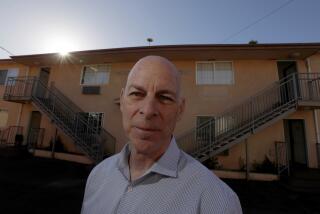Developers Are Flirting With Default
A consortium of developers headed by Christopher Hammond could be deemed in default of its agreement to revitalize a blighted Crenshaw district shopping center, according to a top Community Redevelopment Agency official.
The problem is that Hammond and his associates are behind schedule in finding a retail partner for the Santa Barbara Plaza project, said CRA Deputy Administrator Jonathan Kevles.
But Kevles told the agency’s board at its meeting this month that the $123-million redevelopment project remains “an extremely high priority” for Mayor James K. Hahn and the area’s councilman, Bernard C. Parks, who is running against Hahn in 2005.
Although the CRA has the option of terminating its agreement with Hammond’s consortium and seizing part of its $900,000 deposit, Kevles said such a move is unlikely, given the good faith Hammond has demonstrated pursuing the difficult project.
“To exercise our right to end the agreement would be unnecessary and, in fact, would be, I think, bad faith on our part,” Kevles told the board.
As the project approaches a final vote at the CRA board’s next meeting, Hammond has altered his proposal to add more market-rate housing and to scale back a community center and retail space. His modifications are driven by rising costs for land and building materials, Kevles said.
Last year Hahn and the City Council approved a $37-million subsidy to spur redevelopment of Santa Barbara Plaza, at Crenshaw and Martin Luther King Jr. boulevards. The sprawling, dilapidated Santa Barbara Plaza, which will be renamed Marlton Square, is an eyesore to those who live nearby in the wealthiest African American neighborhoods west of the Mississippi.
An increase in the city subsidy is out of the question, Kevles said.
Hammond is hoping the project will vault him into the ranks of major commercial builders, despite a recent history of tax liens and bounced checks.
His latest plan calls for reducing proposed retail space by 14% and eliminating plans for a free-standing community center, according to the CRA.
The community center, which was to occupy two of the site’s 22 acres, would instead be added to the project’s retail center.
Total retail space would be 120,000 square feet, down from the original 140,000 square feet. A Costco store, by comparison, averages 136,000 square feet.
The revised plan calls for 150 condominiums to be built in place of the free-standing community center, increasing the development’s revenue potential. The condominiums would be sold at market rates, as would 140 single-family homes on nearly nine acres.
The project also includes 180 units of subsidized apartments for senior citizens. A hole has been dug for that part of the project, but, as of last week, construction had not yet begun. At least one of those 180 units must receive a temporary certificate of occupancy by the end of the year or the project could lose the federal tax credits that make it economically feasible.
Some city officials said they are concerned that the senior housing is behind schedule.
Hammond has been unable to come to an agreement with at least two prospective retail partners.
Kevles identified the latest possible partner as Lennar Corp., a publicly traded company that describes itself as a homebuilder. He said a letter of agreement has been drafted but not signed.
Hammond, meanwhile, appears to continue having severe personal financial difficulties, narrowly avoiding a foreclosure sale on a Malibu beach house in his wife’s name this month.
Last month, The Times reported that Hammond has a reputation as a deadbeat. A review of court and campaign records and interviews turned up three dozen instances in which he or his companies bounced checks totaling more than $200,000 from 1999 through 2003. Many were for campaign contributions to local politicians. Others were in private business dealings and included checks to settle lawsuits for bad debts.
In addition, records show that he and his principal company, Capital Vision Equities, owe the federal and state governments $521,222 in back taxes for nine of the last 15 years.
Hammond said in June that he had received a loan from an individual he would not name that would make it possible for him to pay off all tax obligations and bring his mortgages up to date.
But last week, a review of public records showed, the tax liens remained on the books.
More to Read
Sign up for Essential California
The most important California stories and recommendations in your inbox every morning.
You may occasionally receive promotional content from the Los Angeles Times.










